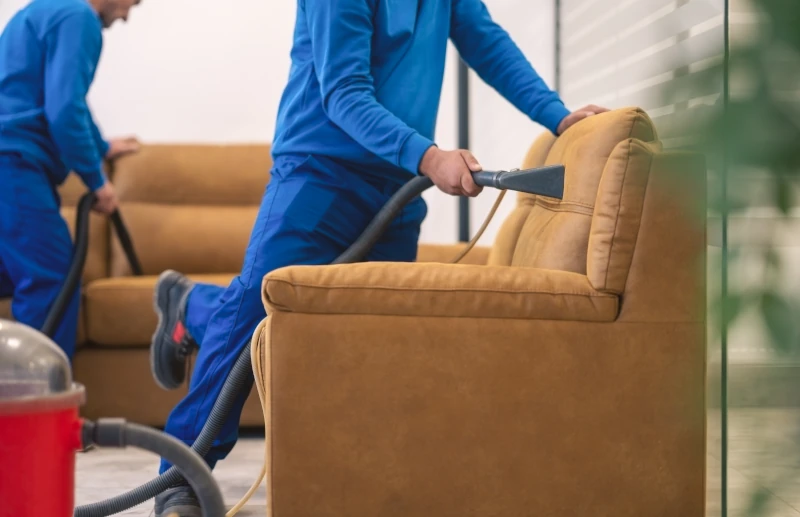April 10th, 2024
Upholstered furniture adds comfort, style, and warmth to any space, whether it's a cozy living room or a professional office setting. However, over time, upholstery can accumulate dirt, dust, stains, and odors, detracting from its appearance and comfort. Regular upholstery cleaning is essential for maintaining the cleanliness and freshness of your furniture and extending its lifespan. In this comprehensive guide, we'll explore upholstery cleaning essentials for both home and business owners, providing valuable tips and techniques to keep your furniture looking and feeling its best.
Understanding the Importance of Upholstery Cleaning:
Upholstered furniture is a significant investment, and proper maintenance is essential to protect your investment and ensure its longevity. Here are some key reasons why upholstery cleaning is important:
- Removes Dirt and Allergens: Like carpets, upholstered furniture acts as a magnet for dirt, dust, pet dander, and allergens. Regular cleaning removes these contaminants, improving indoor air quality and reducing allergy symptoms for occupants.
- Preserves Fabric Integrity: Dirt and debris can accumulate in the fibers of upholstery, causing them to become dull, faded, and worn over time. Regular cleaning helps preserve the integrity of the fabric, preventing premature aging and maintaining the appearance of your furniture.
- Eliminates Stains and Odors: Spills, accidents, and everyday use can result in stains and odors on upholstered furniture. Proper cleaning techniques can effectively remove stains and neutralize odors, leaving your furniture looking and smelling fresh.
- Enhances Aesthetic Appeal: Clean, well-maintained upholstery enhances the overall aesthetic appeal of your space, creating a welcoming and inviting environment for residents, guests, and customers alike.
Upholstery Cleaning Techniques:
Effective upholstery cleaning involves a combination of techniques and tools designed to safely and thoroughly clean upholstered furniture. Here are some common upholstery cleaning techniques:
- Vacuuming: Regular vacuuming is the first line of defense against dirt, dust, and debris on upholstered furniture. Use a soft brush attachment to gently vacuum upholstery, paying attention to crevices, seams, and tufted areas.
- Spot Cleaning: For small stains and spills, spot cleaning is an effective way to address them promptly before they set in. Blot the stain with a clean, damp cloth, working from the outside in to prevent spreading. Avoid rubbing or scrubbing, as this can damage the fabric.
- Upholstery Shampooing: Upholstery shampooing involves using a specialized upholstery cleaning solution and a soft brush or sponge to agitate the fabric and lift dirt and stains. After shampooing, rinse the fabric thoroughly with clean water and allow it to dry completely.
- Steam Cleaning: Steam cleaning, also known as hot water extraction, is a deep cleaning method that uses hot water and detergent to penetrate upholstery fibers and extract dirt and debris. Steam cleaning is effective for removing embedded dirt and stains while sanitizing the fabric.
- Dry Cleaning: Dry cleaning is a low-moisture cleaning method that uses specialized cleaning solvents to dissolve dirt and stains without saturating the fabric. Dry cleaning is ideal for delicate fabrics or upholstery that cannot tolerate moisture.
Upholstery Cleaning Tips for Home and Business Owners:
In addition to professional cleaning techniques, here are some tips for home and business owners to maintain clean and fresh upholstery:
- Read Manufacturer's Instructions: Before cleaning upholstery, always check the manufacturer's instructions and recommendations for cleaning and care. Some fabrics may require special cleaning methods or products to avoid damage.
- Test in an Inconspicuous Area: Before applying any cleaning solution to upholstery, test it in an inconspicuous area to ensure compatibility and prevent damage to the fabric.
- Use Gentle Cleaning Solutions: When cleaning upholstery, use mild, pH-balanced cleaning solutions that are safe for the fabric. Avoid harsh chemicals or abrasive cleaners, as they can damage or discolor upholstery.
- Blot, Don't Rub: When dealing with spills or stains, blot the affected area with a clean, absorbent cloth to soak up the liquid. Avoid rubbing or scrubbing, as this can push the stain deeper into the fabric or damage the fibers.
- Allow Proper Drying Time: After cleaning upholstery, allow it to dry completely before using the furniture again. Proper drying prevents mold and mildew growth and ensures that the fabric retains its shape and texture.
Upholstered furniture adds comfort, style, and personality to any home or business environment. By understanding the importance of upholstery cleaning and implementing proper cleaning techniques and maintenance practices, home and business owners can keep their furniture looking and feeling fresh for years to come. Whether it's regular vacuuming, spot cleaning, or professional upholstery cleaning, investing time and effort into upholstery maintenance pays off in the long run, preserving the beauty and longevity of your furniture. With these upholstery cleaning essentials, you can revitalize your space and create a clean, inviting environment that reflects your style and personality.
